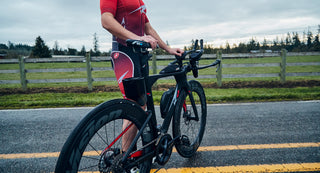From the article:
If you haven’t heard of A2 Bikes before, let’s quickly catch you up: Founder AJ Alley was a new triathlete looking to buy a bike that wouldn’t bankrupt him. He researched why carbon bikes were disproportionately expensive, and found that a lot of the markup happened between the factory and the end consumer. In an effort to bypass this middle-man system, Alley decided to source directly from Taiwan and sell to customers with minimal markup. In an era when Canyon and even now Specialized sell consumer direct, Alley was something of a pioneer.
His original offering, the Speed Phreak came in at $1,900 for a 105 groupset with a full carbon frame. The frame was aggressive enough that you could get the front end dangerously low, but still held a straight line surprisingly well. It was stable enough to be beginner friendly, but could still cut corners and get super aero.
A2 Bikes SP1.2: The Basics
Though A2 doesn’t offer their newest bike for under $2,000 (note: pretty much nothing carbon exists under $3k nowadays), their 105 model (mechanical disc brakes) still comes in at $2,800 and is a staggeringly good value. A2 also makes a mechanical Ultegra SP1.2 for $3,500 (and a hydraulic brake version for $500 more), an Ultegra Di2 SP1.3 for $6,000, and an SP1.4 Dura-Ace Di2 or SRAM Red version for $8,000—all have the same frame.
The frame is quite a bit updated from the very bare bones original Speed Phreak. The SP1.x series was designed by engineer Kevin Quan and his team—the same group responsible for the head-turning Diamondback Andean. Prior to that project, Quan was the senior engineer at Cervelo from 2003-2008. A2 used Computational Fluid Dynamics (CFD) to redesign the Speed Phreak shape and spent time in the wind tunnel, they say.
Aerodynamics aside, the latest iteration has more of an emphasis on fit (which was quite frankly a bit of a weakness on the original) via an adjustable stem and seatpost mast, which we’ll get into in more detail below. The SP1.x also has storage and hydration options that are surprisingly brand agnostic (more below) and is only offered in disc brake versions—where the last Speed Phreak was rim-brake only.
RELATED: Disc Brakes: Do Triathletes Need Them?
A2 Bikes SP1.2: The Features
Because there are quite a few new aspects of the SP1.x, we’ve broken down the most notable new features, in order of importance below.
Aerodynamics – This is obviously a tough one, as we haven’t taken the SP1.x to the wind tunnel, but the fact that Kevin Quan has attached his name to the project is certainly notable. The original Speed Phreak looked, well, like any Taiwanese carbon frame mold, with a laser-straight top tube from the seat tube and not a lot else. The new version has a super tight rear diamond and deep head tube—eerily reminiscent of Trek’s new third-gen Speed Concept. It also has well-hidden disc brakes, compared to the original’s nasty front fork-mounted rim caliper.


Front End – Here was another spot where the original Speed Phreak struggled. The stem on the last version was either slammed or slammed, and while you could raise the aerobars with spacers, it made for a staggeringly aggressive base bar situation. The only thing that made it manageable was the Speed Phreak’s geometry-defying stable handling. With the SP1.x, the new stem not only proved for more built-in adjustability (20mm of fore/aft and 40mm rise stock), but the front end is also compatible with Vision’s ACR system if you really prefer to go low.

Seatpost Head – This is one of those pieces that is often overlooked, but can make or break a bike if you’re looking to get into a specific position or maybe stretch across a given size. The previous Speed Phreak had a fine seatpost head, but the new one is a burly sliding head that gives up to 120mm of fore-aft adjustment—before even accounting for sliding way forward or backward on the seat rails. Sadly you do need to remove the seat to slide (and in some cases disassemble the seatpost head unit), but it’s unlikely that you’ll change your seat angle often.

Storage/Hydration Options – The original Speed Phreak did have ahead-of-its time top tube mount bosses for super-solid bento box mounting, but that was about it. The new SP1.x retains those top-tube bosses and standard cage mounts on the downtube and seat tube, but also adds surprising Bontrager SpeedBox-compatible bosses on the rear of the seat tube, tucked very very low, near the wheel.

A2 Bikes SP1.2: The Good
It goes without saying that one of the biggest and most notable features of this bike is the price. Without the sub-$3k 105 version of this carbon tri bike we might not be talking about the SP1.x series at all. When it comes to entry-level tri bikes—carbon or not—there literally isn’t anything new in that price range. Sure, you can find something used (probably), but you’d do so at your own risk. Below is the full model breakdown with availability:
|
MODEL |
PRICE |
AVAILABILITY |
|
SP1.1 |
$2,800 |
April |
|
SP 1.2 Ultegra mechanical |
$3,500 |
May |
|
SP1.2 Hydraulic brakes |
$4,000 |
May |
|
SP1.3 Di2 Ultegra |
$6,000 |
April |
|
SP1.4 Di2 Dura-Ace/Red |
$8,000 |
Fall |
* All bikes can be upgraded with Vision Metron wheels 55mm ($1,800), 81s ($1,900), or a front 81 and a rear disc ($2,000). And/or Vision TFA Aero Bars ($1,000).
To put it into context, this is what other sub-$4k “entry-level” tri bikes look like right now:
Canyon Speedmax CF 7 Disc (105, hydraulic disc) – $3,800
Argon 18 E-117 Tri Disc (SRAM Force, hydraulic disc) – $3,500
Dimond Carbonado (105, rim brake) – $3,500
Cervelo P-Series (105, mechanical disc) – $3,400
Quintana Roo PRFour Disc (105, mechanical disc) – $3,250
BMC Time Machine ONE (full 105, rim brake) – $2,800
Specialized Shiv Sport (Tiagra, rim brake) – $2,200
Kestrel Talon X (105, rim brake) – $1,700
So while the SP1.2 hydraulic version is about on par with the Speedmax CF 7 Disc and the Argon 18 no one is making a bare-bones, entry-level bike with disc brakes for under $3,000.
Price aside, the new SP1.x series does have much better aero details, fit flexibility, and front-end adjustment. While the aerodynamics can’t be verified, the designer’s pedigree is solid, and the refinements look eerily similar to the tirelessly researched new Trek Speed Concept.

In terms of fit flexibility, the seat angle positions (based on far forward and backward the seat rails can move on the seat post head) are on par with, if not better than, bikes that make a big deal of this—for instance the Scott Plasma 6 or Quintana Roo’s V-PR. Up front, you won’t find many superbikes that are as adjustable as the SP1.x, and the adjustments are easy and don’t require four hands and carpentry clamps.
We also loved that extra frame bosses for everything from standard water bottles (aero bottles work too, but the seat tube boss is so low in the frame, two aero bottles would be nearly impossible) to a fixed bento box to the Bontrager SpeedBox bosses in the back. Smart move on A2’s part by simply co-opting a well-known and easily sourced brand’s storage option.

In terms of ride quality, the SP1.2 we rode sits squarely in the middle of the rough/smooth spectrum, maybe landing a little more on the rough side when compared to high-end bikes like the Speed Concept or Plasma, but those bikes are literally three times the price. For a bike that won’t make you sell your car to buy, it’s a smooth, well balanced ride across the whole spectrum of low- to high-frequency road chatter.
While we’ll touch on the bike’s handling below (spoiler alert, kind of), we also liked the low-key branding and matte, stealth paint job/aesthetics. This is unsurprisingly a bike for those who do not care about brand names, and as such, it’s hard to find so much as a logo on this frame.
A2 Bikes SP1.2: The Not-Awesome
On paper, the SP1.2 is a great bike at a great price. True, it’s not the lightest bike out there at 22 pounds, 2 ounces, but I dare you to find another aero tri bike substantially lighter for under $5k (especially with weighty hydraulic disc brakes and mechanical shifting). But otherwise, the build is solid, the fit is flexible, and it’s not a terribly tough bike to work on.
Even when on the road, the road feel isn’t so rough that it bears mentioning: Throw some carbon wheels on it or upgrade the aerobars a little bit, and you have something that’s at least in the ballpark of bikes roughly three times the price.
However, we had some problems when it came to handling on this bike that were tough to pin down. First, we had the bike professionally assembled by a bike delivery service—which is fairly unusual for our review process, as I usually build them myself. Even so, there aren’t a lot of moving parts in the front end (thankfully) that could cause problems, and we checked every important bolt twice before hitting the road.
Out on the road, the handling was a little tricky. Even though the bike was on the larger side—which usually indicates a more stable ride—straight line handling was tough. While in the aerobars, there was a need for minor adjustments on straightaways and downhills, even without a ton of wind. In the basebars, the need for adjustments was even more pronounced. It was tough to get a predictable line on the SP1.2 whether in a straightaway or around a mild to moderate corner; tight corners needed quite a bit of rider feedback. As such, cornering was not particularly confidence-inspiring.
For sure, one could adjust to this handling style after a ride or two, but it was notable when compared to other bikes at any pricepoint. It’s also possible that this was a one-off situation—maybe something about the fork/stem/bar interaction, but for sure nothing was loose, per se. Finally, it should be noted that the base bars were set low on the stem and the aerobars—because of the larger size—were set at a medium height on the risers, so it wasn’t an issue of overstacked risers or a lifted basebar.
Conclusions
Handling quirkiness aside, this is still a fully capable bike for someone looking to get onto a carbon tri rig without spending a ton of money. For sure this bike has a place in the tri world as something affordable, easy-to-fit/setup, and well-designed in terms of aerodynamics. While there are always some risks involved in going with a small or direct-to-consumer bike situation—no fitting, no in-person customer service for any issues, etc.—this is no longer unique to a company like A2. Whereas before we’d dedicate entire paragraphs on why a consumer-direct model can be different and risky, it’s almost a moot point, given how many bikes people are purchasing online, sight unseen.
We commend A2 for bringing in a great designer to put together the aerodynamics of this bike and doing their best to keep the cost down in what can only be described as a mad scrum market for components—handling aside, there’s not much that lets this bike “show” its low-budget leanings. While I won’t expect to see a lot of the Dura-Ace/Red models being sold come this fall, I know there will be some happy beginner/intermediate triathletes riding and racing on the lower-end offerings as soon as they become available.


